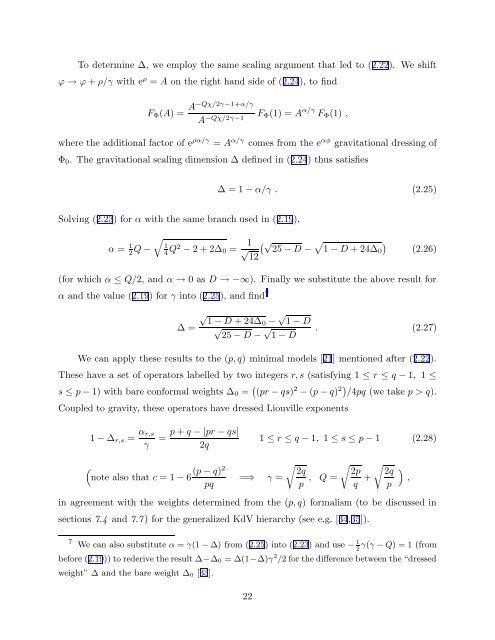arXiv:hep-th/9304011 v1 Apr 5 1993
arXiv:hep-th/9304011 v1 Apr 5 1993
arXiv:hep-th/9304011 v1 Apr 5 1993
Create successful ePaper yourself
Turn your PDF publications into a flip-book with our unique Google optimized e-Paper software.
To determine ∆, we employ <strong>th</strong>e same scaling argument <strong>th</strong>at led to (2.22). We shift<br />
ϕ → ϕ + ρ/γ wi<strong>th</strong> e ρ = A on <strong>th</strong>e right hand side of (2.24), to find<br />
F Φ (A) = A−Qχ/2γ−1+α/γ<br />
A −Qχ/2γ−1 F Φ (1) = A α/γ F Φ (1) ,<br />
where <strong>th</strong>e additional factor of e ρα/γ = A α/γ comes from <strong>th</strong>e e αφ gravitational dressing of<br />
Φ 0 . The gravitational scaling dimension ∆ defined in (2.24) <strong>th</strong>us satisfies<br />
∆ = 1 − α/γ . (2.25)<br />
Solving (2.23) for α wi<strong>th</strong> <strong>th</strong>e same branch used in (2.19),<br />
α = 1 2 Q − √<br />
1<br />
4 Q2 − 2 + 2∆ 0 = 1 √<br />
12<br />
(√<br />
25 − D −<br />
√<br />
1 − D + 24∆0<br />
)<br />
(2.26)<br />
(for which α ≤ Q/2, and α → 0 as D → −∞). Finally we substitute <strong>th</strong>e above result for<br />
α and <strong>th</strong>e value (2.19) for γ into (2.25), and find 7<br />
∆ =<br />
√ 1 − D + 24∆0 − √ 1 − D<br />
√<br />
25 − D −<br />
√<br />
1 − D<br />
. (2.27)<br />
We can apply <strong>th</strong>ese results to <strong>th</strong>e (p, q) minimal models [21] mentioned after (2.22).<br />
These have a set of operators labelled by two integers r, s (satisfying 1 ≤ r ≤ q − 1, 1 ≤<br />
s ≤ p − 1) wi<strong>th</strong> bare conformal weights ∆ 0 = ( (pr − qs) 2 − (p − q) 2) /4pq (we take p > q).<br />
Coupled to gravity, <strong>th</strong>ese operators have dressed Liouville exponents<br />
1 − ∆ r,s = α r,s<br />
γ<br />
p + q − |pr − qs|<br />
=<br />
2q<br />
1 ≤ r ≤ q − 1, 1 ≤ s ≤ p − 1 (2.28)<br />
(p − q)2<br />
(note also <strong>th</strong>at c = 1 − 6<br />
pq<br />
=⇒ γ =<br />
√<br />
2q<br />
p ,<br />
√ √<br />
2p 2q<br />
Q = q + p<br />
)<br />
,<br />
in agreement wi<strong>th</strong> <strong>th</strong>e weights determined from <strong>th</strong>e (p, q) formalism (to be discussed in<br />
sections 7.4 and 7.7 ) for <strong>th</strong>e generalized KdV hierarchy (see e.g. [34,35]).<br />
7 We can also substitute α = γ(1 − ∆) from (2.25) into (2.23) and use − 1 γ(γ − Q) = 1 (from<br />
2<br />
before (2.19)) to rederive <strong>th</strong>e result ∆−∆ 0 = ∆(1−∆)γ 2 /2 for <strong>th</strong>e difference between <strong>th</strong>e “dressed<br />
weight” ∆ and <strong>th</strong>e bare weight ∆ 0 [33].<br />
22
















